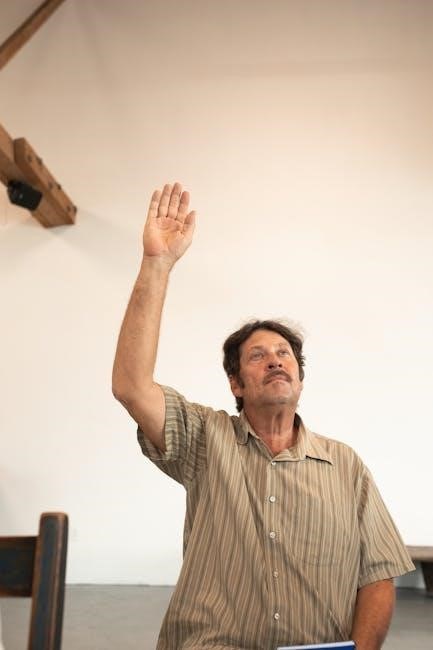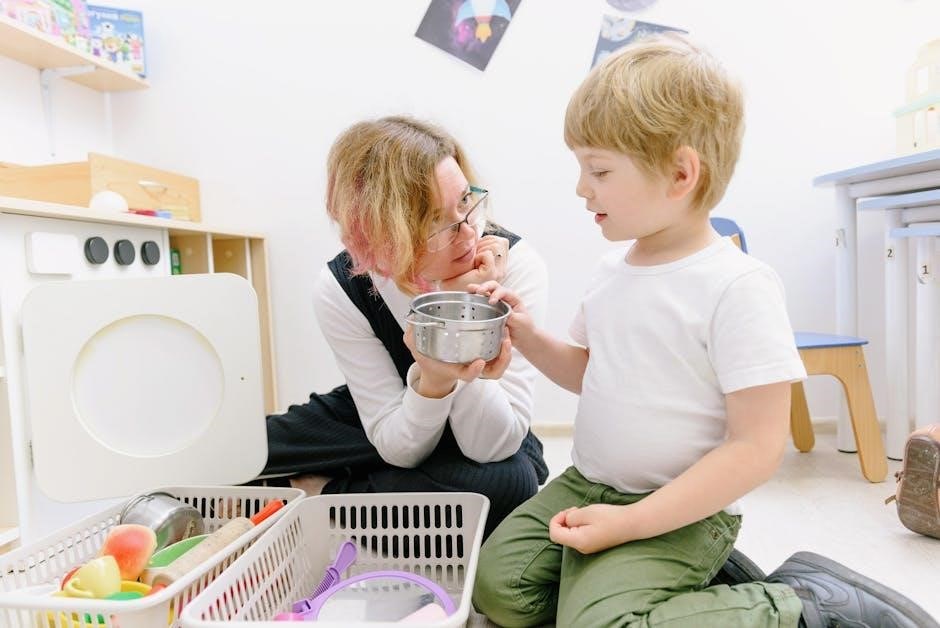Catholic school teaching interviews focus on integrating faith, academic excellence, and moral development. They assess a candidate’s ability to create a supportive, faith-centered learning environment while addressing academic and emotional needs.
1.1. Understanding the Unique Aspects of Catholic Education
Catholic education emphasizes the integration of faith, morality, and academic rigor, creating a holistic learning environment. It focuses on developing the whole child—intellectually, spiritually, and emotionally—through values-based instruction. Teachers are expected to model Catholic virtues and incorporate faith into all subjects, fostering a sense of community and service. The curriculum often includes religious education, prayer, and opportunities for spiritual growth. Understanding these unique aspects is crucial for candidates, as they must align their teaching philosophy with the school’s mission. Catholic schools also prioritize character development, expecting educators to nurture students’ moral and ethical reasoning. This blend of faith and academics sets Catholic education apart, making it essential for interviewees to demonstrate how they can contribute to this distinctive approach.
1.2. Preparing for a Catholic School Teacher Interview
Preparing for a Catholic school teacher interview requires a deep understanding of the school’s mission and values. Research the institution’s specific goals and how faith is integrated into daily activities. Review common interview questions, focusing on your philosophy of Catholic education and how you incorporate faith into teaching. Practice discussing your classroom management style, lesson planning strategies, and ability to foster a supportive learning environment. Highlight your commitment to spiritual growth and academic excellence. Additionally, reflect on how you handle moral and ethical discussions in the classroom. Organize your materials, such as lesson plans and testimonials, to demonstrate your readiness to contribute to the school’s faith-centered community.

Common Interview Questions for Catholic School Teachers
Common questions focus on integrating faith, teaching philosophy, and handling moral discussions; Prepare by researching the school’s mission and practicing thoughtful responses.

2.1. Why Do You Want to Teach in a Catholic School?
Teaching in a Catholic school offers the opportunity to integrate faith with education, fostering holistic development. It aligns with my commitment to nurturing students’ academic, spiritual, and moral growth. The mission of Catholic schools to provide a supportive, faith-centered environment resonates deeply with my values. I believe in the importance of prayer, service, and moral guidance in education, which Catholic schools emphasize. This setting allows me to contribute to students’ formation as compassionate individuals while sharing my passion for learning. I am inspired by the chance to make a meaningful impact on young lives through a faith-based educational approach.
2.2. What Is Your Philosophy of Catholic Education?
My philosophy of Catholic education revolves around fostering a holistic approach to learning, where faith, academics, and moral development are seamlessly intertwined. I believe Catholic schools provide a unique environment where students can grow not only intellectually but also spiritually and morally. The integration of Gospel values into daily lessons and activities is essential for nurturing compassionate, responsible, and faith-driven individuals. I am committed to creating a classroom where prayer, service, and respect for all are central to the educational experience. By aligning my teaching with the Catholic mission, I aim to inspire students to live as disciples of Christ and contribute positively to their communities.
2;3. How Do You Integrate Faith into Your Teaching?
Integrating faith into teaching is a cornerstone of Catholic education. I begin each class with prayer, setting a tone of gratitude and reflection. Lessons are designed to connect academic concepts to Catholic teachings, emphasizing moral values and the importance of living as disciples of Christ. For example, science lessons might explore God’s creation, while literature discussions highlight themes of compassion and justice. I also incorporate faith-based discussions and service projects to help students apply their beliefs in real-world contexts. By weaving faith into daily activities, I create a nurturing environment where students can grow spiritually, academically, and morally.

General Teaching Interview Questions
General teaching interviews often include questions about classroom management, lesson planning, and personal strengths/weaknesses. These inquiries help assess a teacher’s effectiveness and adaptability in educational settings.
3.1. What Inspired You to Become a Teacher?
Many educators are inspired by their own teachers or mentors who made a profound impact on their lives. A passion for helping others learn, shaping young minds, and contributing to their community often drives individuals to pursue teaching. For some, it’s about creating a supportive environment where students feel safe to grow academically and emotionally. Others are motivated by the desire to inspire curiosity and foster a love for learning. In a Catholic school setting, the integration of faith and education further enhances this calling, as teachers aim to nurture both the intellectual and spiritual growth of their students.
- A desire to make a positive impact on students’ lives.
- Inspiration from influential educators in their own lives.
- A commitment to fostering intellectual and spiritual growth.
3.2. What Are Your Strengths and Weaknesses as a Teacher?
When discussing strengths, emphasize qualities like patience, adaptability, and a genuine passion for student growth. Highlight your ability to connect with students, create engaging lessons, and foster a positive classroom atmosphere. For weaknesses, acknowledge areas for improvement, such as time management or integrating technology, and explain how you are actively working to address them. It’s important to demonstrate self-awareness and a commitment to professional development. In a Catholic school setting, align your strengths with the mission of nurturing both academic and spiritual growth, while showing humility and a willingness to grow in your teaching practice.
- Strengths: Patience, creativity, and dedication to student success.
- Weaknesses: Areas for improvement, such as time management or technology integration.
3.3. How Do You Manage Classroom Behavior?
Effective classroom behavior management begins with establishing clear expectations and fostering a respectful, structured environment. I emphasize positive reinforcement, such as verbal praise and incentives, to encourage good behavior. For challenges, I use proactive strategies like redirecting attention, addressing underlying causes, and incorporating restorative practices. In a Catholic school setting, I integrate faith-based values, such as prayer and community-building activities, to promote kindness and responsibility. Maintaining consistent routines and ensuring students feel heard and supported helps minimize disruptions. I also collaborate with parents to ensure a unified approach to behavior management, creating a positive and productive learning atmosphere that aligns with the school’s mission.
- Set clear expectations and consequences.
- Use positive reinforcement and restorative practices.
- Incorporate faith-based values to promote kindness.
- Collaborate with parents for a unified approach.

Lesson Planning and Instructional Strategies
Effective lesson planning involves aligning with curriculum standards, integrating faith, and using differentiated instruction to meet diverse student needs. Incorporating technology and hands-on activities enhances engagement. Assessments are used to monitor progress and adjust strategies.
- Align lessons with curriculum and faith values.
- Use differentiated instruction for diverse learners.
- Incorporate technology and hands-on activities.
- Monitor progress with formative assessments.
4.1. How Do You Develop Lesson Plans for 3rd Grade Students?
Developing lesson plans for 3rd-grade students involves aligning with curriculum standards, integrating Catholic values, and ensuring age-appropriate activities. I start by identifying learning objectives and incorporating faith-based themes. Differentiated instruction is key to meet diverse needs, with hands-on activities and technology to engage students. Lessons are structured to promote critical thinking, creativity, and collaboration. Assessments are integrated to monitor progress and adjust instruction. Prayer and reflection are woven into daily plans to foster spiritual growth. I also consider students’ interests and real-world applications to make learning relevant and meaningful, ensuring a balance of academic rigor and faith formation.
4.2. What Teaching Methods Do You Find Most Effective?
I find that a combination of engaging, interactive, and faith-infused methods works best for 3rd-grade students. Cooperative learning, where students work in small groups, fosters teamwork and collaboration. Storytelling and hands-on activities help make complex concepts relatable and memorable. Incorporating technology, such as educational apps and multimedia resources, enhances engagement. Active learning strategies, like think-pair-share and problem-solving tasks, encourage critical thinking. I also integrate prayer and reflection to connect academic lessons with Catholic values. These methods not only promote academic growth but also support the spiritual and emotional development of students, aligning with the mission of Catholic education.
4.3. How Do You Assess Student Learning and Progress?
To assess student learning and progress, I use a combination of formative and summative assessments. Formative assessments include quizzes, class discussions, and observation of student participation to monitor understanding. Summative assessments, such as unit tests and projects, evaluate mastery of material. I also incorporate reflective journals and peer reviews to encourage self-assessment and collaboration. Additionally, I integrate faith-based assessments, such as prayer reflections and service-learning projects, to evaluate students’ spiritual growth. These methods help me track progress and identify areas where students may need additional support, ensuring a holistic approach to education that aligns with Catholic values.

Classroom Environment and Student Engagement
A positive, inclusive classroom fosters respect, collaboration, and spiritual growth. I create engaging lessons, encourage participation, and integrate faith to promote a supportive, faith-centered learning atmosphere.
5.1. What Would I See, Hear, and Feel in Your Classroom?
In my classroom, you would see a vibrant, organized space with faith-inspired decor, students actively engaged in hands-on activities, and collaborative group work. You would hear respectful conversations, enthusiastic discussions, and the sound of students sharing ideas confidently. The atmosphere would feel welcoming, inclusive, and focused, with a sense of community and mutual support. Faith is woven into daily routines, creating a space where students feel safe to grow academically, socially, and spiritually. Positive reinforcement, movement, and creative expression are integral to fostering a dynamic, faith-centered learning environment that encourages curiosity, kindness, and a love for learning.
5.2. How Do You Create an Inclusive and Supportive Learning Environment?
To create an inclusive and supportive learning environment, I prioritize differentiated instruction to meet diverse needs, ensuring all students feel valued and challenged. I integrate Catholic values of respect, empathy, and compassion into daily interactions, fostering a sense of belonging. By encouraging open communication and active listening, students feel comfortable expressing their thoughts and ideas. I also incorporate collaborative activities that celebrate diversity and promote teamwork. Faith-based discussions and prayer further enrich the environment, reinforcing moral development. Accessibility and flexibility in lesson plans ensure equity, while positive reinforcement and restorative practices help build a culture of kindness and mutual respect.
5.3. How Do You Encourage Student Participation and Engagement?
To encourage student participation and engagement, I use interactive and hands-on activities that cater to different learning styles. I incorporate technology, such as educational apps and multimedia resources, to make lessons dynamic and relatable. Group discussions, role-playing, and collaborative projects foster teamwork and active involvement. I also use positive reinforcement, such as verbal praise and incentives, to motivate students; By creating a safe and respectful environment, students feel confident to share their ideas and take risks. Additionally, I align activities with real-world applications and Catholic values, such as service and compassion, to deepen their connection to the material and inspire meaningful participation.

Catholic Faith and Moral Development
Catholic faith and moral development are central to education, fostering compassion, integrity, and service. Prayer, values, and faith-based lessons guide students’ spiritual and ethical growth.
6.1. How Do You Teach Catholic Values in the Classroom?
Teaching Catholic values in the classroom involves integrating faith into daily lessons, fostering prayer, and modeling virtues. Incorporate faith-based discussions, service projects, and character development activities. Use Catholic teachings to guide moral decision-making and promote compassion. Encourage students to reflect on their actions and choices, aligning them with Catholic principles. Create a supportive environment where faith and academics intertwine, helping students grow spiritually and ethically. Emphasize the importance of kindness, respect, and responsibility, ensuring students understand the connection between faith and their daily lives. This approach nurtures holistic development, preparing students to live as thoughtful, faith-driven individuals in their communities.
6.2. How Do You Handle Discussions on Sensitive Moral Topics?
Handling sensitive moral topics in a Catholic classroom requires care, respect, and alignment with Church teachings. Begin by creating a safe, open environment where students feel comfortable sharing thoughts. Use the Catechism and Church documents to guide discussions, ensuring clarity and fidelity to Catholic values. Address topics like forgiveness, respect, and honesty in age-appropriate ways, emphasizing moral reasoning. Encourage empathy and understanding while reinforcing Catholic principles. Involve parents and the school community in fostering consistent moral guidance. By balancing sensitivity with faith-based instruction, you help students navigate complex issues while deepening their understanding of Catholic values and ethical decision-making.
6.3. What Role Does Prayer Play in Your Teaching?
Prayer is central to Catholic education, serving as a foundation for spiritual growth and fostering a Christ-centered environment. I begin and end each day with prayer, involving students to create a sense of community and mindfulness. Prayer is also integrated during transitions, before tests, or special events, helping students connect with their faith. I encourage reflection on Catholic values through prayer, ensuring it aligns with Church teachings. This practice helps students develop a personal relationship with God while modeling prayer as a source of strength and guidance. By prioritizing prayer, I create a nurturing atmosphere where faith and learning intertwine, supporting the school’s mission and students’ spiritual development.

Working with Parents and the School Community
Building strong partnerships with parents and the school community is vital. Effective communication through emails, newsletters, and parent-teacher conferences fosters collaboration and mutual support, ensuring student success and a united faith-based environment.
7.1. How Do You Communicate with Parents?
Effective communication with parents is essential for student success. Regular updates through emails, newsletters, and parent-teacher conferences ensure transparency and collaboration. I also encourage open dialogue, fostering a trusting relationship. By being approachable and responsive, I create a supportive environment where parents feel valued and informed about their child’s progress. Additionally, I utilize school communication platforms to share updates and engage parents in their child’s education. This holistic approach ensures alignment with Catholic values, promoting mutual respect and shared goals. Clear, consistent, and compassionate communication helps build a strong partnership between home and school, benefiting the child’s academic and spiritual growth.
7.2. How Do You Collaborate with Other Teachers and Staff?
Collaboration with colleagues is vital for a cohesive educational environment. I actively participate in team meetings, share resources, and seek input to ensure aligned teaching strategies. By fostering open communication and mutual respect, we create a supportive network that benefits both students and staff. I also engage in professional development opportunities with colleagues to enhance our collective expertise. Additionally, I contribute to school-wide initiatives and events, demonstrating a commitment to the broader school community. This collaborative spirit, rooted in Catholic values, strengthens our ability to provide a unified and nurturing environment for all students, ensuring their academic, emotional, and spiritual growth.
7.3. How Do You Engage with the School Community?
Engaging with the school community is essential for fostering a positive and inclusive environment. I actively participate in school events, such as parent-teacher conferences, volunteer opportunities, and extracurricular activities. Building strong relationships with parents, students, and staff helps create a sense of belonging and shared purpose. I also communicate regularly with families through newsletters, emails, and parent meetings to keep them informed about their child’s progress. By being approachable and involved, I contribute to a welcoming atmosphere that reflects the values of a Catholic education. This proactive approach strengthens connections and supports the spiritual and academic growth of the entire school community.

Scenario-Based Questions
Scenario-based questions assess your problem-solving skills and ability to integrate faith in challenging situations. They often involve practical teaching scenarios, requiring thoughtful, faith-centered responses to maintain a supportive environment.
8.1. How Would You Handle a Disruptive Student?
Handling a disruptive student requires a balanced approach that maintains classroom order while addressing the student’s needs. I would first assess the situation to understand the cause of the disruption. A proactive approach involves creating engaging lesson plans and building positive relationships to prevent misbehavior. If disruption occurs, I would address it calmly and privately to avoid embarrassment. Using positive reinforcement, I would redirect the student’s behavior and reinforce expectations. Consistent consequences, aligned with school policies, would follow if necessary. Additionally, I would reflect on the incident to identify patterns and collaborate with parents or counselors for support. This approach ensures a respectful, faith-centered environment focused on student growth and well-being.
8.2. How Would You Support a Struggling Learner?
Supporting a struggling learner begins with identifying their specific needs through assessments and observations. I would implement differentiated instruction, tailoring lessons to meet individual learning styles and abilities. Small group activities and one-on-one tutoring would provide targeted support. I would also incorporate visual aids and hands-on activities to make learning engaging and accessible. Additionally, I would integrate faith by encouraging prayer and Catholic values to foster perseverance and confidence. Regular communication with parents would ensure a collaborative effort to support the student’s progress. By creating a nurturing and inclusive environment, I aim to help each student grow academically, emotionally, and spiritually, reflecting the compassion and care central to Catholic education.
8.3. How Would You Address a Student’s Emotional Needs?
Addressing a student’s emotional needs requires empathy, patience, and a faith-centered approach. I would create a safe and supportive environment where students feel comfortable expressing their feelings. By integrating Catholic values, such as compassion and kindness, I would encourage open communication and help students develop self-awareness. I would also use restorative practices to foster reconciliation and understanding. If needed, I would collaborate with school counselors or parents to provide additional support. Prayer and reflection would be incorporated to guide students in navigating their emotions. My goal is to help students grow emotionally and spiritually, ensuring they feel valued and supported in their educational journey.
Professional Development and Growth
Professional development is crucial for educators to enhance teaching skills and stay updated on best practices. Attending workshops, retreats, and collaborating with peers fosters growth.
9.1. How Do You Stay Updated on Educational Best Practices?
To stay updated on educational best practices, I regularly attend professional development workshops, conferences, and retreats focused on Catholic education. I also engage in online courses and subscribe to educational journals to stay informed about innovative teaching methods. Collaborating with colleagues and participating in school-wide training sessions helps me integrate new strategies into my classroom. Additionally, I reflect on my teaching practices through self-assessment and seek feedback from peers to continuously improve. By staying connected with the broader educational community, I ensure my teaching remains aligned with current standards while fostering a faith-centered learning environment.
9.2. What Professional Development Opportunities Do You Seek?
I seek professional development opportunities that align with Catholic education and enhance my teaching skills. Workshops on faith integration, classroom management, and differentiated instruction are priorities. I also look for conferences on innovative teaching methods and technology integration to stay current. Collaborating with other Catholic educators through professional networks and retreats helps me grow spiritually and professionally. Online courses on curriculum design and special needs support are also valuable. By pursuing these opportunities, I aim to create a more engaging, inclusive, and spiritually enriching learning environment for my students while deepening my understanding of Catholic educational principles.
9.3. How Do You Reflect on Your Teaching Practices?
Reflecting on my teaching practices is essential for growth and improvement. I regularly review lesson plans, assess student outcomes, and consider feedback from colleagues and students. This reflection helps me identify strengths and areas for development. I also integrate Catholic values by evaluating how well I model and teach faith principles. Collaborating with peers and participating in professional development further enrich my reflective process. My goal is to continuously refine my methods to create a more engaging, effective, and faith-centered learning environment that supports the holistic development of each student while staying true to the mission of Catholic education.

Final Thoughts and Next Steps
Express gratitude for the opportunity, highlight enthusiasm for the role, and align your goals with the school’s mission. Ask thoughtful questions to demonstrate commitment and engagement.
10.1. What Excites You About Teaching at This School?
What excites me most is the opportunity to contribute to a faith-centered education that nurtures both academic and spiritual growth. I am inspired by the school’s commitment to creating a supportive, inclusive community that values moral development and service. Teaching in a Catholic school allows me to integrate faith into daily lessons, fostering a holistic approach to learning. I am eager to collaborate with a dedicated staff and engage with a curriculum that emphasizes compassion, integrity, and excellence. The chance to inspire young minds in a nurturing environment aligned with my values is truly fulfilling and motivates me to make a meaningful impact.
10.2. What Do You Hope to Achieve in This Role?
In this role, I aim to create a transformative learning experience that combines academic rigor with spiritual growth. I hope to foster a love for learning, helping students develop into compassionate, morally grounded individuals. By integrating faith into lessons, I aim to inspire students to live out Catholic values in their daily lives. I also strive to build strong relationships with students, parents, and colleagues, creating a collaborative and supportive community. Ultimately, I hope to make a lasting impact on students’ lives, equipping them with the skills and values needed to succeed in both their academic and personal journeys, guided by faith and integrity.
10.3. Do You Have Any Questions for Us?
Asking questions during an interview demonstrates engagement and interest in the role. You might inquire about the school’s approach to integrating faith into the curriculum or how the community supports teacher professional development. Understanding the school’s culture, such as extracurricular activities or parent-teacher collaboration, can provide insights into how you can contribute effectively. Additionally, asking about the resources available for teaching and the expectations for student outcomes can help align your goals with the school’s mission. Thoughtful questions not only show your commitment but also help you determine if the school aligns with your values and teaching philosophy, ensuring a mutually beneficial fit.
